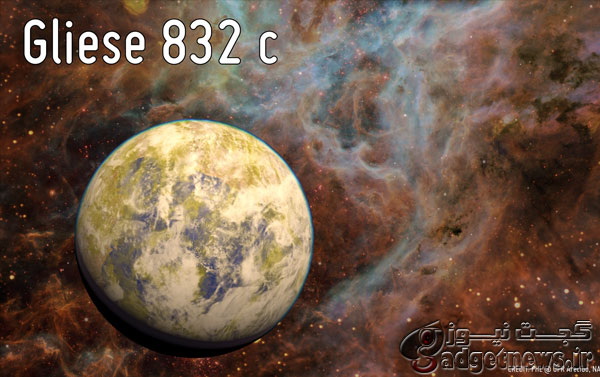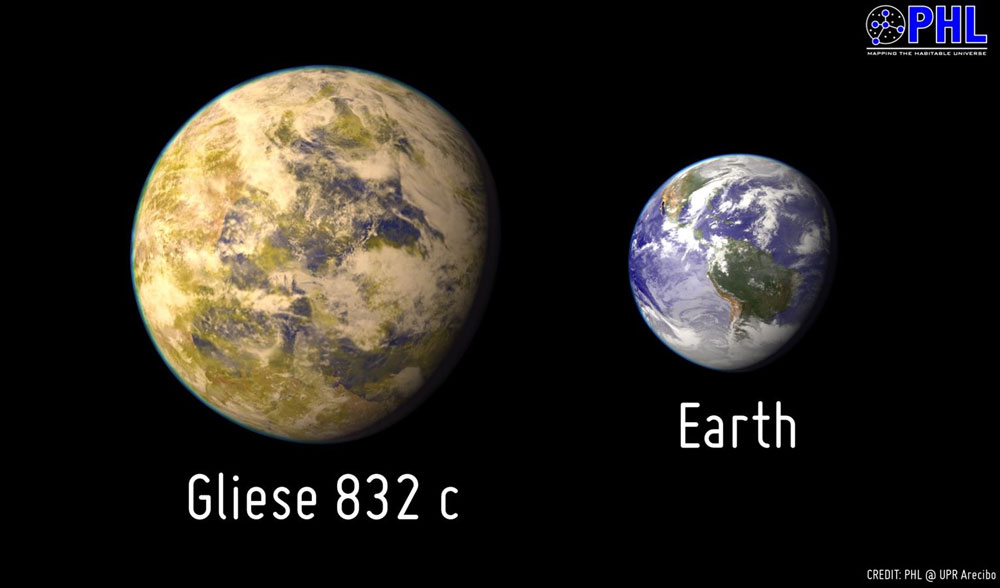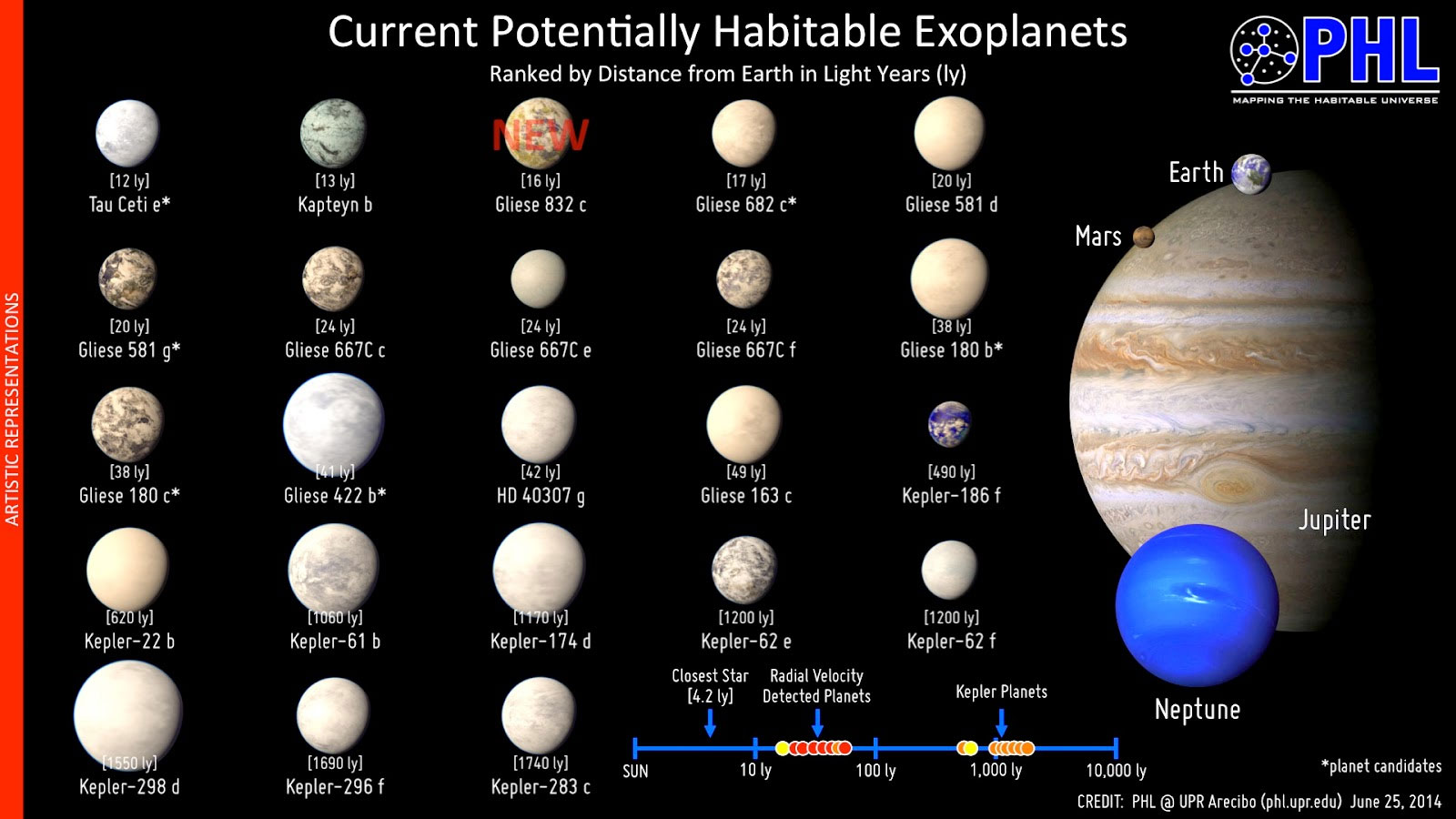
ستاره شناسان سیاره ای ابر زمین را کشف کردند که در فاصله ۱۶ سال نوری از ما قرار دارد، محققان معتقدند این سیاره بهترین نامزد برای پشتیبانی از حیات میباشد. شاید در یک شب صاف ، شما هم قادر باشید با استفاده از یک تلسکوپ ، ستاره کوتوله قرمز ۸۳۲ Gliese را که این سیاره در مدار آن واقع شده را مشاهده کنید.

تصویری هنری از سیاره تازه کشف شده Gliese832c در کنار زمین که حداقل جرمی ۵ برابر سیاره ما دارد.
محققان دانشگاه نیوساوتولز در استرالیا با بررسی تغییرات ناشی از گرانش این سیاره در زمان حرکات ستاره میزبان موفق به شناسایی سیاره Gliese832c شدند. این سیاره ابر زمین تازه کشف شده جرمی ۵ برابر زمین دارد، اما شرایط دمایی آن تقریبا شبیه سیاره ما بوده و و دارای تغییرات فصلی مشابه فصلهای زمین است. این سیاره بیگانه در منطقه قابل سکونت ستاره Gliese832 در فاصله ۱۶ سال نوری از زمین واقع شده است که فاصله مناسب برای داشتن آب به شکل مایع محسوب میشود؛ یک دور چرخش کامل این سیاره به دور ستاره میزبان ۳۶ روز بطول میانجامد.
ستاره میزبان (Gliese832) یک کوتوله قرمز، بسیار کمنورتر و سردتر از خورشید است، به همین دلیل سیاره تازه کشف شده، انرژی ستارهای معادل زمین دریافت میکند که باعث میشود این سیاره بیگانه در جمع سه سیاره شبهزمین جای بگیرد. این ستاره میزبان سیاره بیگانه شبهمشتری به نام Gliese832b است که در سال ۲۰۰۹ شناسایی شده بود؛ سیاره Gliese832c نیز که به تازگی کشف شده است، به فهرست سیارات بیگانه قابل سکونت اضافه شده و این رقم به ۲۳ سیاره افزایش پیدا کرد.

کاتالوگ سیارات قابل سکونت: در این تصویر 23 سیاره کشف شده را که همانند زمین در فاصله مناسبی از ستارگان خود قرار دارند را مشاهده می کنید.
این کشف با استفاده از استفاده از طیفنگار روی تلسکوپ آنجلو استرالیان (Anglo-Australian) واقع در استرالیا، طیفنگار سیارهیاب کارنگی بر روی تلسکوپ ماژلان II در شیلی و طیفنگارHARPS تلسکوپ رصدخانه جنوبی اروپا در شیلی انجام شد.
منبع : universetoday
On a clear night, you might be able to spot the red dwarf star Gliese 832 through a backyard telescope, as it is just 16 light years away. Today, astronomers announced the discovery of super-Earth planet orbiting this nearby star and say it might be the best candidate yet for habitable world.
Gliese 832c was spotted by an international team of astronomers, led by Robert A. Wittenmyer from UNSW Australia. They used high-precision radial-velocity data from HARPS-TERRA, the Planet Finder Spectrograph and the UCLES echelle spectrograph. This star is already known to have one additional planet, a cold Jupiter-like planet, Gliese 832 b, discovered in 2009.
Since red dwarf stars shine dimly, the habitable zones around these stars would be very close in. Gliese 832c complies with an orbital period of 36 days (it’s orbital companion Gliese 832 b orbits the star in 9.4 years.)
The newly found super-Earth has a mass at least five times that of Earth’s and the astronomers estimate it receives about the same average energy as Earth does from the Sun. “The planet might have Earth-like temperatures, albeit with large seasonal shifts, given a similar terrestrial atmosphere,” says a press release from the Planetary Habitability Laboratory. “A denser atmosphere, something expected for Super-Earths, could easily make this planet too hot for life and a ‘Super-Venus’ instead.”
Using the Earth Similarity Index (ESI) — a measure of how physically similar a planetary mass object is to Earth, where 1 equals the same qualities as Earth — Gliese 832 c has an ESI of 0.81. This is comparable to Gliese 667C c (ESI = 0.84) and Kepler-62 e (ESI = 0.83).
“This makes Gliese 832c one of the top three most Earth-like planets according to the ESI (i.e. with respect to Earth’s stellar flux and mass) and the closest one to Earth of all three, a prime object for follow-up observations. However, other unknowns such as the bulk composition and atmosphere of the planet could make this world quite different to Earth and non-habitable.”
In their paper, Wittenmyer and his colleagues noted that while Solar Systems like our own appear — so far — to be rare, the Gliese 832 system is like a scaled-down version of our own Solar System, with an inner potentially Earth-like planet and an outer Jupiter-like giant planet. They added that the giant outer planet may have played a similar dynamical role in the Gliese 832 system to that played by Jupiter in our Solar System.
Certainly, astronomers will be attempting to observe this system further to see if any additional planets can be found.
 گجت نیوز آخرین اخبار تکنولوژی، علم و خودرو
گجت نیوز آخرین اخبار تکنولوژی، علم و خودرو 





